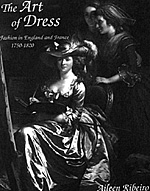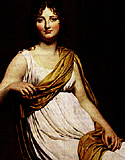

Author: Aileen Ribeiro
Pages: 267
Illustrations: 192 black and white and 63 color reproductions of period paintings and illustrations.
Maps: None
Footnotes: 577, most annotated, presented by chapter at the end of the book.
Appendices: None
Bibliography: 246 sources noted.
Index: 1,378 entries
Publisher: Yale University Press, New Haven, Connecticut
Publication Date: 1995
Binding: Cloth (hardbound)
ISBN: 0-300-06287-7
Price: $55.00
Summary: The Art of Dress discusses fashion in England and France (and some examples of other European dress) from 1750-1820 as a badge of rank, a prop in portraiture, and an expression of an individual's ideology and aesthetics. It is a gorgeous collection of period artwork, including portraits, fashion plates, and photographs of surviving articles of clothing and artists' paraphernalia. Ribeiro's approach is both uplifting and convincing in its careful exploration of the symbology of personal appearance. The author exposes the ways society and culture impose class distinctions and hierarchy through clothing.
Aileen Ribeiro's opus explains why the Age of Reason urged rational dress with individual touches, but without affectations. Fashion was influenced by practicality, morality and, unfortunately, novelty, spurring the hedonistic consumerism of the Industrial Age. Oscar Wilde, famous playwright and satirist of the late 19th Century, wryly observed that fashion was a "form of ugliness so intolerable that we have to alter it every six months." Dress reformers were heartened by the simplification of clothing around 1800.
Her book shows how art of the period 1750 to 1820 took two directions away from the overly elaborate style of Rococo used in the previous era. The Neoclassical style was fueled by the cult of antiquity that was an integral part of the French Revolutionary movement, and by actual antiquities brought to the Louvre from Italy and Egypt by campaigning French armies in the 1790's. The Troubadour style, based on the class of lyric poet-musicians of the 12th and 13th centuries in Provence and northern Italy, appeared when religious orders were eliminated by Robespierre, and their confiscated medieval treasures displayed in the Musee des Monuments.
The author compares the ways in which art referring to Sparta and Rome was used to ennoble the democracy, martial Rome to motivate the Directory, and Renaissance opulence to sanctify the First Empire.
In order to achieve a timeless quality to painting and to add dramatic sweep, most artists advocated historical dress, or at least court dress. The book juxtaposes a surviving coat with its portrait to show how an artist adds his own interpretation even when painting an accurate likeness.
 Ribeiro examines whether clothing for a portrait was chosen by the sitter, or selected or even invented by the artist, which determines whether portraiture gives an accurate view of the times. A certain pose may have been impossible in the corsets and complicated fastenings of the time, but such clothing denotes rank because servants were required for help when dressing. Accessories such as fans and shawls have a language of signals that can be interpreted from contemporary accounts.
Ribeiro examines whether clothing for a portrait was chosen by the sitter, or selected or even invented by the artist, which determines whether portraiture gives an accurate view of the times. A certain pose may have been impossible in the corsets and complicated fastenings of the time, but such clothing denotes rank because servants were required for help when dressing. Accessories such as fans and shawls have a language of signals that can be interpreted from contemporary accounts.
The author explains that fashion was a reflection of, and can be an influence on, history. Jacques-Louis David's Oath of the Tennis Court, one of the most powerful images from the French Revolution, records the creation of the National Assembly. There is a stark contrast between the demeaning and impersonal black suits decreed for the members of the Third Estate in David's illustration and the portrait of Marie Antoinette in her violet and silver lame gown. (Ironically, the French Queen preferred simple dresses similar to the Neoclassical styles to come.) Portraits after the French Revolution contain the tricolor cockades which were worn for survival, and soon required by law.
After the French Revolution, Ribeiro notes, wise citizens changed their appearance to advertise support for the current government. Disheveled hair and rumpled clothing implied that a man had more important matters to think about than fashion. The new English styles of the frock coat and trousers were taken from stablehands, and were more practical as well as politically correct. First for safety, later for respectability, one had to appear in the streets dressed as a businessman rather than as one of the idle rich.
In an understated reference, Ribeiro tells of a new fashion magazine in 1790 publishing ambiguous plates of men in black, apparently attempting to predict the political future of France through dress: The black color of the men's suits alluded either to democracy or to mourning for the monarchy. During the Terror the magazine was closed.
The book notes that well-to-do incroyables wore powdered hair and huge green cravats in support of the aristocracy. Combined with variations on exaggerated frock coats with tight waists and huge collars, scandalous knit breeches, and riding boots, these men were targets for caricaturists and Jacobin gangs. Most men of means wore a slim version of the English country gentleman's garb.
The Art of Dress details how industrialization increased supply and subsequent demand for a greater variety of fabrics. Outerwear was made of coarse wool, tailored coats of smooth-finished wool, vests of silk, cravats and shirts of crisply starched cotton. Linen was worn by the poor. The new abundance of white undergarments in the wardrobe allowed more frequent laundering, so coats were always dark to highlight the freshened whites.
Ribeiro adds touches of humor to her work, as when she describes Beau Brummel, an English military officer who resigned to live a life of pleasure, elevated the already fashionable English frock coat to the obvious mark of wealth by investing in perfect tailoring. The records of clothing purchased by his admirer, future King George, derided as the "Prince of Whales," prove that some men wore corsets.
The Directory in France brought back middle-class preferences, and consumerism increased. Ribeiro states that fewer ladies of fashion wore the scandalously sheer neo-classical gowns in the fashion plates. These draperies of translucent thin cottons clung to and outlined the natural body shape, only lightly altered by supporting bodices or corsets. Sleeveless and shortsleeved gowns were very shocking at their time. Multiple petticoats were reduced to a single short shift.
The Art of Dress devotes a significant amount of space to the Consulate and First Empire. For his ministers, Napoleon brought back the embroidered silks and velvets in confining styles, as well as the hat constantly clutched under the arm. As most men had become accustomed to the looser frock coat, a portrait of Director Devillers shows him shifting uncomfortably in his civil uniform. Napoleon also wished their hair to be powdered and tied into a black silk bag. Men with short hair had to fasten the empty bag to the back of their collars.
The author quotes Marshal Ney as saying, "If the Emperor wishes to encourage velvet-wearing and embroidery, I am very willing to buy dress coats; but as to wearing them, that is another matter." Napoleon's opinion was: "Not everyone has the right to dress simply."
Ribeiro notes that Napoleonic civil uniforms denoted rank by color and amount of embroidery. They were to give "dignity, discipline and structure to a new society," but this conflicted with the new pursuit of individualism. Unlike the other two Consuls, Napoleon did not wear lace at the neck and cuffs, but instead wore the black military cravat, "...dressed in Blue, much more plain than His Officers, which gave him additional consequence, for the power and splendour of his situation was marked by the Contrast, as commanding all that brilliant display."
The author notes how this changed with Napoleon's coronation, which drew upon Renaissance symbology in the fashions, embroideries and in the redecoration of Notre-Dame. The bee symbolized hard work for his people. "The court of the new Charlemagne...assumed a character of Gothic grandeur, wholly destructive to that tone of republican simplicity which Brutus Bonaparte had once contributed to establish."
Other Book Reviews
- The Culture of Clothing: Dress and Fashion in the Ancien Regime
- Napoleon's Traitor: The Masons and Marshal Ney's Mysterious Escape
- As Befits a Legend: Building a Tomb for Napoleon
Back to Table of Contents -- Napoleon #5
© Copyright 1996 by Emperor's Press.
This article appears in MagWeb (Magazine Web) on the Internet World Wide Web.
The full text and graphics from other military history magazines and gaming magazines are available at http://www.magweb.com